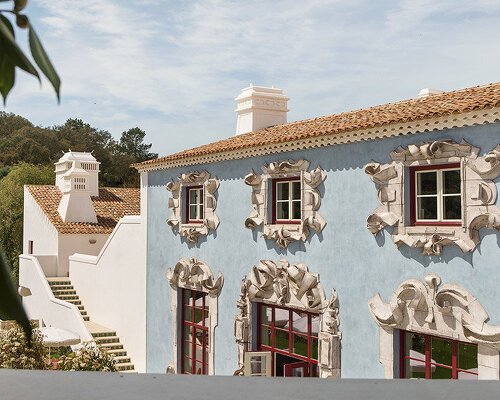Vermelho: Christian Louboutin’s Boutique Hotel in Melides
Vermelho, a boutique hotel realized by Christian Louboutin, architect Madalena Caiado and interior designer Carolina Irving, is located in the village of Melides, Portugal. The project marks the fashion designer’s first foray into hospitality, shaped by his longtime connection to the Alentejo region and realized in collaboration with local and international artisans.
With just thirteen rooms, the hotel is conceived as an intimate retreat, its scale aligned with the character of the village. The architecture by Madalena Caiado establishes a framework of whitewashed forms and traditional Portuguese detailing. This emphasizes the many layers of craftsmanship and decorative work.
images © Ambroise Tézenas, courtesy of Vermelho Hotel
Architecture and Spatial Experience
Vermelho Hotel, designed by Christian Louboutin, Madalena Caiado and Carolina Irving, is organized like a villa rather than a resort, with courtyards, gardens, and shared rooms encouraging interaction among guests. Exterior spaces are animated by sculptural interventions from Italian artist Giuseppe Ducrot, whose ceramics extend across facades in a series of baroque-inspired frescos and ornamental figures. His work folds into the architecture itself, creating a sense of permanence rather than applied decoration.
Inside, expressive ceilings and tiled floors set the stage for an eclectic layering of furnishings and objects collected by Louboutin. The design avoids uniformity as each room is individually composed with antique pieces, patterned textiles, and handcrafted surfaces to draw on Iberian traditions and reflecting the designer’s personal aesthetic.
Christian Louboutin opens his first boutique hotel in Melides, Portugal
red for layers of symbolism
The name Vermelho, meaning red in Portuguese, signals both Louboutin’s signature color and a wider embrace of cultural references. Local craftsmanship underpins much of the interior. Artisans from the Fábrica de Azulejos de Azeitão produced custom tiles for bedrooms and the deeply pigmented red flooring, using centuries-old techniques that remain central to Portuguese identity.
Lighting is handled by India’s Klove Studio, whose blown-glass chandeliers bring scale and theatricality to the reception hall. Their green-and-gold installation combines traditional glasswork with contemporary design, signaling a global reach while reinforcing the handmade ethos of the project.
architect Madalena Caiado shapes the hotel with whitewashed forms and courtyards
Throughout the hotel, surfaces and furnishings reveal the work of collaborators who specialize in historic crafts. In Seville, the workshop of Villarreal created a hammered silver-leaf bar for the lounge, continuing a legacy of goldsmithing developed for Spanish liturgical traditions.
‘The beautifully chiseled objects that accompany the Holy Week processions in Spain made the reputation of this liturgical goldsmith’s workshop founded in 1954 by Manuel Villarreal Fernández in Seville,’ the team explains. ‘Today, the Sevillian workshop is run by the founder’s son, Francisco Villarreal Reina.’ The layering of materials — silver, ceramics, glass, and textiles — creates a textural richness that resonates with the building’s white stucco frame.
Vermelho is designed as a ornate and intimate retreat with just thirteen rooms
The restaurant, Xtian, extends the home-like atmosphere with dining rooms that pair Portuguese cuisine with interiors that feel both rooted and informal. Furniture and fabrics emphasize tactility here, making the experience of dining at once with the crafted environment. Rattan chairs are custom-designed by Maison Gatti, a workshop founded in 1920, and bought in 2019 by the entrepreneur Alexis Dyèvre.
‘After Christian and Alexis met, they went to the manufacturer in Fontainebleau many times,‘ the team at Vermelho continues. ‘This is where Christian decided to design a chair for Xtian restaurant. Together they imagined a bespoke style for the hotel with the Vermelho chair, inspired by a 19th-century design from the Maison Gatti archives. It has also experimented with new uses for its iconic canework, applying it to closet doors in some rooms and communal areas.’
each interior space is unique with antique furnishings and patterned textiles
Italian sculptor Giuseppe Ducrot created ceramic facades and baroque frescos
Klove Studio crafts a green and gold glass chandelier for the reception
Portuguese artisans from Azeitão produce custom tiles and deep red floors
project info:
name: Vermelho Hotel | @hotelvermelho
location: Melides, Portugal
architecture: Madalena Caiado
interior design: Carolina Irving | @carolinairvingtextiles
facade: Giuseppe Ducrot | @giuseppeducrot
lighting: Klove Studio | @klove.studio
tiles: Fábrica de Azulejos de Azeitão | @azulejosdeazeitao
photography: © Ambroise Tézenas | @ambroisetezenas
The post christian louboutin opens vermelho, a boutique hotel in portugal with ornamental red details appeared first on designboom | architecture & design magazine.

